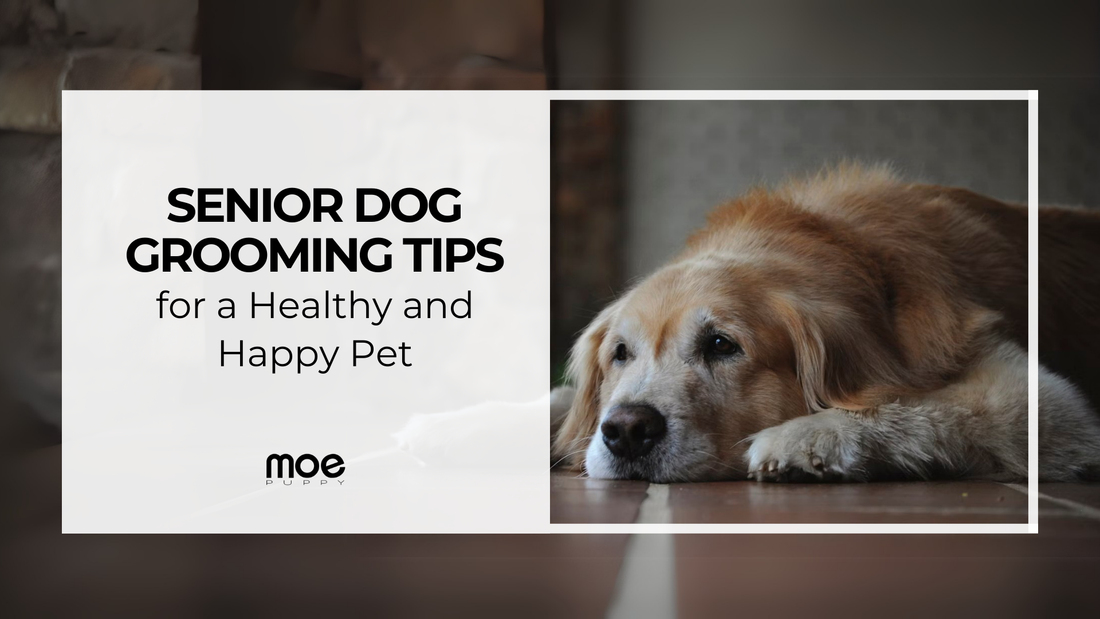
Senior Dog Grooming Tips for a Healthy and Happy Pet
Share
As our beloved dogs grow older, their grooming needs change significantly. Senior dogs require special care to keep them comfortable, healthy, and happy. Regular grooming not only maintains their appearance but also helps in detecting health issues early. If you have an aging furry companion, here are some essential senior dog grooming tips to ensure they stay in their best shape.
Understanding the Grooming Needs of Senior Dogs
Older dogs often experience changes in their skin, coat, nails, and overall hygiene. These changes require a more gentle and thoughtful grooming approach. Aging can lead to:
- Thinner, more sensitive skin
- Reduced oil production, making the coat drier
- Brittle nails that require frequent trimming
- A weakened immune system, making them more prone to infections
By adjusting grooming routines to suit these needs, you can help your senior dog feel more comfortable and relaxed.
1. Brushing: Keeping the Coat Healthy
Choose a Gentle Brush
Senior dogs often have thinner coats and sensitive skin, so using a soft-bristle brush or a grooming glove is ideal. Regular brushing helps remove loose fur, prevents matting, and stimulates blood circulation.
Brush Regularly
Aim to brush your senior dog at least 3-4 times a week. Long-haired breeds may need daily brushing to prevent tangles and mats, which can cause discomfort.
Check for Skin Issues
While brushing, check for lumps, sores, dry patches, or signs of infection. Early detection of skin problems can prevent more severe issues down the road.

2. Bathing: Keeping Your Senior Dog Fresh
Use a Mild Shampoo
Senior dogs often have dry or sensitive skin, so choose a hypoallergenic or oatmeal-based shampoo to avoid irritation. Avoid frequent baths, as they can strip natural oils.
Use Lukewarm Water
Cold water can be uncomfortable, while hot water can dry out the skin. Always ensure the bathwater is warm but not too hot.
Try a Waterless Grooming Kit
If your senior dog struggles with traditional baths, consider using a Waterless Grooming Kit. This can help keep them clean and fresh without the stress of a full bath.
Support Their Joints
Older dogs may have arthritis, making it difficult to stand for long periods. Use a non-slip mat in the tub and offer extra support to keep them comfortable.
3. Nail Trimming: Preventing Pain and Mobility Issues
Trim Nails Frequently
Senior dogs are often less active, leading to longer nails that can cause pain or difficulty walking. Trim their nails every 2-3 weeks using a dog-friendly nail clipper or grinder.
Be Cautious of the Quick
Older dogs’ nails can have longer quicks (the blood supply inside the nail). Trim small portions at a time to avoid cutting too close and causing bleeding.
Use a Paw Balm
Dry, cracked paw pads are common in senior dogs. Applying a paw balm can help keep them soft and prevent cracking.
4. Ear Cleaning: Preventing Infections
Check for Wax Buildup
Older dogs may develop more ear wax, leading to infections. Use a vet-approved ear cleaner and a soft cotton pad to gently wipe away dirt.
Look for Signs of Infection
If you notice redness, swelling, a bad odor, or excessive head shaking, consult a vet immediately. These could be signs of an ear infection.
5. Dental Care: Keeping Teeth and Gums Healthy
Brush Their Teeth Regularly
Dental problems are common in senior dogs, leading to pain, bad breath, and infections. Use a soft-bristle toothbrush and dog-safe toothpaste to brush their teeth at least 3 times a week.
Use Dental Chews
If brushing is difficult, offer vet-approved dental chews or water additives to help reduce plaque buildup.
6. Managing Shedding and Dander
Use a Deshedding Tool
If your senior dog sheds a lot, a deshedding brush can help remove loose fur and reduce dander in your home.
Keep Them Hydrated
Dry skin can increase shedding. Ensure your dog drinks enough water to maintain a healthy coat.
Invest in Air Purifiers
Air purifiers help reduce pet dander in your home, benefiting both you and your senior dog.
7. Checking for Lumps and Bumps
Regular Body Checks
Senior dogs are more prone to developing fatty lumps or tumors. During grooming sessions, gently run your hands over their body to check for any unusual growths.
Consult a Vet if Needed
Not all lumps are dangerous, but a vet should examine any new or growing masses.
8. Grooming Senior Dogs with Arthritis
Use a Grooming Table or Elevated Surface
If your dog struggles to stand, grooming them on a raised surface can reduce strain on their joints.
Keep Sessions Short
Long grooming sessions can be tiring. Break them into smaller, more manageable parts to keep your dog comfortable.
9. Keeping Your Senior Dog Calm During Grooming
Be Gentle and Patient
Older dogs may be more sensitive and anxious. Speak in a soothing voice and use slow, gentle movements.
Use Treats and Positive Reinforcement
Reward your dog with treats and praise to create a positive grooming experience.
Consider Professional Grooming
If grooming at home becomes too challenging, professional groomers experienced with senior dogs can provide safe and stress-free grooming sessions.
10. Maintaining a Grooming Routine
Consistency is key when grooming senior dogs. Regular sessions help keep their coat, nails, ears, and teeth in top condition, preventing potential health issues.
Taking care of a senior dog requires extra love and attention, but with the right grooming routine, you can ensure they stay comfortable and happy in their golden years.

Conclusion
Grooming is an essential part of senior dog care. By using gentle techniques, checking for health issues, and maintaining a regular grooming schedule, you can keep your aging pet happy and healthy. Always pay attention to changes in their skin, coat, and overall behavior, as these may indicate underlying health problems. With patience and proper care, your senior dog can continue to enjoy a comfortable and joyful life.
For an easier and stress-free grooming experience, consider using the Waterless Grooming Kit to keep your senior dog clean without the hassle of traditional bathing.

